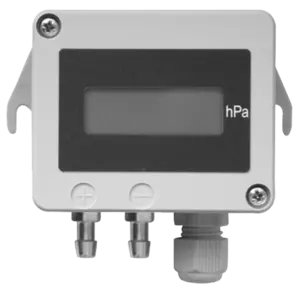
JUMO multirange and differential pressure transmitter
- Measuring range: 2.5 hPa to 100 hPa DP
- Zero point adjustment possible
- 0(2) to 10 V or 0(4) to 20 mA






Differential pressure sensors measure the difference between 2 absolute pressures p1 and p2 in gases, steam, and liquids. Among other applications they can be found in filter monitoring, level measurement in closed containers, and safety-critical systems. They are often referred to as differential pressure transmitters or differential pressure transducers.
A differential pressure sensor has 2 hermetically/air-tight sealed chambers, each with a process connection, which are separated from each other by a flexible membrane with a glued on resistance bridge. The process connections are connected in front of and behind a possible pressure reduction so that the pressures act on the membrane in the opposite direction. If the pressure in the chambers is the same, the membrane remains flat. When the pressure in one of the chambers decreases or increases, the membrane tilts towards the chamber with the lower pressure
How does a differential pressure transducer work? - JUMO FAQ
A distinction is made between piezoresistive and capacitive measurement. Most differential pressure sensors are now based on the piezoresistive effect (the change in electrical resistance of a material caused by tension or pressure). This effect is achieved by metallic strain gauges, which are glued to the elastic membrane already mentioned, or by silicon wafers.
What are the different types of differential pressure sensors? - JUMO FAQ
Differential pressure sensors are found wherever pressure ratios have to be continuously measured and checked (for example in filter monitoring or flow measurement).